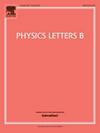用ACT数据处理彩虹变形的f(R)重力
IF 4.5
2区 物理与天体物理
Q1 ASTRONOMY & ASTROPHYSICS
引用次数: 0
摘要
在这项工作中,我们研究了一个理论场景,它结合了早期宇宙的两个基本理论建议和早期后暴胀时代的可能演变。具体来说,我们假设早期宇宙包含引力对时空的彩虹效应,暴胀拉格朗日广义相对论包含R2修正或f(R)引力修正。此外,我们假设在膨胀结束后直到再加热温度达到的时代,是一个kinination时代。R2和引力彩虹这两种理论都是从量子环境中产生的,所以它们的影响应该首先在连接量子和经典的理论中进行检查,因此膨胀。时空是四维的,量子理论的影响可能会印在膨胀拉格朗日量上,当然也会印在时空本身上。对于引力彩虹变形的Starobinsky模型,将拉格朗日量子效应和时空量子效应结合起来。正如我们所示,所得理论与ACT数据兼容,关于光谱指数。我们还考虑幂律f(R)重力变形,并证明在这种情况下,模型是可行的,无需延长膨胀的慢滚时代。本文章由计算机程序翻译,如有差异,请以英文原文为准。
Confronting rainbow-deformed f(R) gravity with the ACT data
In this work we examine a theoretical scenario which combines two fundamental theoretical proposals for the early Universe and a possible evolution for the early post-inflationary epoch. Specifically, we assume that the early Universe contains gravity’s rainbow effects on the spacetime and the inflationary Lagrangian contains corrections or gravity corrections in general. In addition we assume that the era beyond the end of inflation until the reheating temperature is reached, is a kination era. Both theories, and gravity’s rainbow emerge from a quantum context so their effects should be first checked at the theory which connects the quantum with the classical, hence inflation. Spacetime is four dimensional and the effects of the quantum theory could possibly be imprinted in the inflationary Lagrangian and of course on the spacetime itself. For the gravity’s rainbow deformed Starobinsky model, both Lagrangian quantum effects and spacetime quantum effects are combined. As we show the resulting theory is compatible with the ACT data, regarding the spectral index. We also consider power-law gravity deformations and we show that in this case, the model is viable without the need of extending the slow-roll era of inflation.
求助全文
通过发布文献求助,成功后即可免费获取论文全文。
去求助
来源期刊

Physics Letters B
物理-物理:综合
CiteScore
9.10
自引率
6.80%
发文量
647
审稿时长
3 months
期刊介绍:
Physics Letters B ensures the rapid publication of important new results in particle physics, nuclear physics and cosmology. Specialized editors are responsible for contributions in experimental nuclear physics, theoretical nuclear physics, experimental high-energy physics, theoretical high-energy physics, and astrophysics.
 求助内容:
求助内容: 应助结果提醒方式:
应助结果提醒方式:


